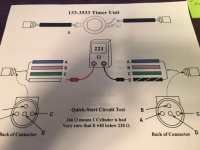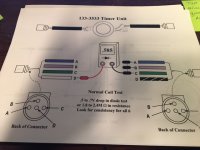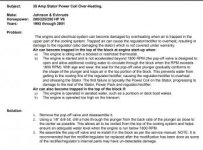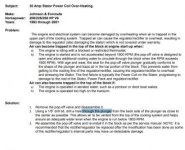twilly1127
Member
I have a issue with my 2001 Johnson Ocean Pro 200HP Model J200VXSIF . Engine has good compression, starts and sounds like a champ in drive way but when the engine is warm now. I have NO fire on one cylinder. #2 port side middle. If i swap the plug wire from #1 or 3, into #2 (the one thats not firing) then #2 will fire and the other one will not... tells me the ignition coil pack is good for that cylinder since it fires immediately if i swap plug wires.
The issue appears to be following the wire off the power pack to ignition coil... But it seems i only lose spark after the engine is warm.
I have put new plugs in, and replaced the power pack this past weekend with a replacement from CDI.
Cleaned off the ignition coil and plug wires, checked all wire plugs / harness for corrosion and everything looks good.
Fired it up in drive way and she sounded great. all 6 are firing, sounded strong, no back fire, no misfire or stall. let it run 10 min at 900-1100 rpm no issue. Dropped in water, Test drive fail . NO FIRE at all ........on #2 port side same cylinder as before!!!! #poundsDesk.
still have this same issue with a new power pack!! Last 2 weeks it has been a hit or miss and a intermittent issue.. I drove 20 miles no issue, anchor for a while, hour or two later go to leave and it's missing. I would turn off and back on many times and eventually it would fire and run good.
Currently after warm #2 will not produce spark... (I did not have to remove the fly wheel to change the power pack) I have 14 volts running, so the stator should be good? the magnets are not lose. I have no idea what to change next. Timer base? it runs great initially its only after warm from what it seems and i know a faulty power pack when warm can produce same symptoms. Any help would be greatly appreciated.
I believe a ignition coil either works or it don't... i am wondering if its not getting enough voltage / energy from #2 off the power pack to fire the coil. Since it's only a 30$ part i am going to replace but do not want to throw money away and considering when i move plug wires it works, i don't think that is the victim here. I have read the rectifier, trigger switch, shift switch, ignition coil, timer base, power pack,stator, plugs could all be a part of this same issue. I don't mind investing some money to get this work horse going again but i don't want to throw another part until i get some input.
I have downloaded the CDI troubleshooting book and plan to do some OHM / volt tests and go from there.
Wondering if anyone else experienced something like this the other post i read the dude had a bad connection from his ignition coil to cylinder plug.
If i take this some where and they don't sea trial it then every thing looks and appears FINE... It makes no sense. when all 6 hit the motor runs like a champ. Has to be a silly issue..... PLEASE HELP! Thank you
The issue appears to be following the wire off the power pack to ignition coil... But it seems i only lose spark after the engine is warm.
I have put new plugs in, and replaced the power pack this past weekend with a replacement from CDI.
Cleaned off the ignition coil and plug wires, checked all wire plugs / harness for corrosion and everything looks good.
Fired it up in drive way and she sounded great. all 6 are firing, sounded strong, no back fire, no misfire or stall. let it run 10 min at 900-1100 rpm no issue. Dropped in water, Test drive fail . NO FIRE at all ........on #2 port side same cylinder as before!!!! #poundsDesk.
still have this same issue with a new power pack!! Last 2 weeks it has been a hit or miss and a intermittent issue.. I drove 20 miles no issue, anchor for a while, hour or two later go to leave and it's missing. I would turn off and back on many times and eventually it would fire and run good.
Currently after warm #2 will not produce spark... (I did not have to remove the fly wheel to change the power pack) I have 14 volts running, so the stator should be good? the magnets are not lose. I have no idea what to change next. Timer base? it runs great initially its only after warm from what it seems and i know a faulty power pack when warm can produce same symptoms. Any help would be greatly appreciated.
I believe a ignition coil either works or it don't... i am wondering if its not getting enough voltage / energy from #2 off the power pack to fire the coil. Since it's only a 30$ part i am going to replace but do not want to throw money away and considering when i move plug wires it works, i don't think that is the victim here. I have read the rectifier, trigger switch, shift switch, ignition coil, timer base, power pack,stator, plugs could all be a part of this same issue. I don't mind investing some money to get this work horse going again but i don't want to throw another part until i get some input.
I have downloaded the CDI troubleshooting book and plan to do some OHM / volt tests and go from there.
Wondering if anyone else experienced something like this the other post i read the dude had a bad connection from his ignition coil to cylinder plug.
If i take this some where and they don't sea trial it then every thing looks and appears FINE... It makes no sense. when all 6 hit the motor runs like a champ. Has to be a silly issue..... PLEASE HELP! Thank you
Last edited:





